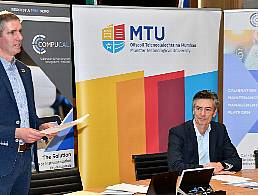Karie Willyerd discusses why mosaic careers are the future for flexible workers and how employers are going to have to get on board.
According to CLO in residence and advisor at Skillable, Karie Willyerd, a mosaic career refers to how an individual can build a varied career through varying projects and gigs that align with their interests, skills, needs and their stage of life.
“It suits people who want variety in their work day, who desire or need greater flexibility and autonomy in their work life, who don’t desire a single role and others who may simply eschew the traditional nine-to-five,” she told SiliconRepublic.com.
“Mosaic careers are an interesting phenomenon for individuals and organisations since they provide greater flexibility and agility for both parties. For individuals, pursuing a mosaic career could be attractive since the workplace no longer guarantees full-time job security or a decades-long career.”
According to Willyerd, it is probable that today’s employees will change careers at least three times throughout their lives and this is a figure that will, in all likelihood, rise as AI and automation transform jobs and the skills that are required.
“Building a mosaic career can help workers navigate the shifting sands of today’s workplace, while building transferable skills and experience that provide some future-proofing.”
She has found that more and more people are turning to alternative work styles, such as freelancing, contracting, consulting and semi-retirement, to match their needs and obligations.
“This may be due to perceived job insecurity, as spreading your income over several organisations could be a better bet than solely relying on a single employer. A mosaic work style can also help someone fit in caring commitments, further education, or other external responsibilities.”
Future-ready
For Willyerd, the future-proofing element of a mosaic career is a key benefit, as fluid, interchangeable skills enable professionals to move between gigs, organisations and industries, when impacted by unforeseen disruption.
In her opinion, this freedom of movement, while not a guarantee of another role elsewhere, enables employees to better protect themselves and access a wider jobs market, when compared to permanent workers who are tied to a single organisation.
Speaking to her own experience of having this kind of career trajectory, she stated that by having a varied career and amassing skills that can be broadly applied, she has been able to work with companies that are of genuine interest to her, align with her purpose in life and give her the opportunity to work on other projects, for example writing and research.
She noted it is not only the individual who gains from exposure to the principles of alternative working models. “Employers benefit from mosaic careers as their workforces are more agile, they can be upscaled and downscaled depending on demand and people can be deployed across projects to ensure their skills are always being fully used.
“It can build a breadth of skills if someone is able to apply their skills in different contexts they otherwise wouldn’t be able to in a permanent role. A writer may be able to create blogs, press releases, whitepapers, email copy and more if they are working across multiple gigs. Over time, this can create a more rounded skill profile and greater experience.”
Retention also deserves a mention, said Willyerd, as companies can hold on to talented employees for longer by offering flexible, mosaic career options. Working parents would likely appreciate the autonomy that comes with a less structured timetable, while someone approaching retirement age still has plenty to offer a business, in terms of upskilling and training.
Embrace the new
When it comes to the perception and expectations of working life, times are changing. As professionals become more discerning and exercise their right to negotiate working conditions, employers are going to have to get on board to a certain degree, or risk losing the competitive edge.
“Employers need to understand that traditional work styles no longer work for individuals or organisations. We face a chronic skills gaps in many industries and employers need to be creative in sourcing people with the right skills, and retaining those people,” said Willyerd.
“Staying rigidly in a traditional employment structure will ultimately hinder growth for employers and their employees. People won’t be able to experience new areas, build new skills, or future-proof their careers and organisations won’t have workforces who are constantly learning, cross-skilling and ready to deploy into new areas.”
For Willyerd, traditional models, such as the standard ladder system, are being deconstructed whether employers are ready for it or not. She finds that younger generations, Gen Z and millennials, are eager to explore what employment means for them and what opportunities are awaiting.
“That may be the ladder system for some people and for others, it can be a mosaic career choice. Ultimately it depends on the individual. It’s a positive move for the workplace, giving people more choice over how they work, what they work on, when, and in some cases, where.”
Lighting the way
For the professionals who think they would like to experience a mosaic career, Willyerd emphasised the importance of having a ‘North Star’, lest you wander aimlessly with little growth.
“If you are embarking on a mosaic career, make sure you are clear on your long-term career goals. For some, that can be building specific skills and experience, for others, it might be supporting your family through school or a specific period of time. Interests and passions may also be your North Star.”
She also advised remaining mindful of your goals, as they will influence the skills that you need and the areas you need to educate yourself on. “Document your progress and results for future opportunities. This could be in a dedicated portfolio of your best projects and testimonials, which is helpful for someone in ‘creator’ careers such as design, coding and marketing,” she said.
“Collecting manager and peer feedback can also help provide proof of your abilities when results aren’t available. Look for ways to prove your skills, from on-the-job projects that show your experience, to performance-based assessments and scores that validate your skills through data.”
But ultimately, for Willyerd, the most powerful tool you can have in your arsenal as you navigate your career, is purpose. “I look at every project and potential new organisation through this lens so my mosaic career perfectly aligns with my purpose. That gives me motivation and greater satisfaction long-term.”
Don’t miss out on the knowledge you need to succeed. Sign up for the Daily Brief, Silicon Republic’s digest of need-to-know sci-tech news.




